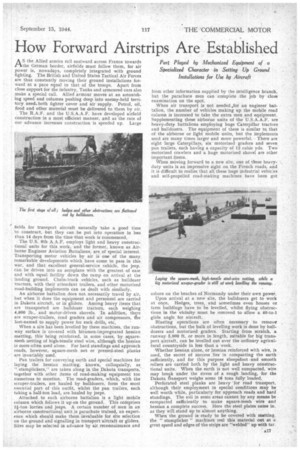How Forward Airstrips Are Established
Page 19

If you've noticed an error in this article please click here to report it so we can fix it.
AS the Allied armies roll eastward across France towards the German border, airfields must follow them, for air power is, nowadays, completely integrated with ground fighting. The Britiah and United States Tactical Air Forces are thus constantly moving their ground installations forward at a pace equal to that of the troops. Apart from close support for the infantry, Tanks and armoured cars also make a special call. Allied armour moves at an astonishing speed and columns pushing deep into enemy-held territory neeth both fighter cover and air supply. Petrol, oil, food and other material must be delivered to them by air,
The R.A,F• and the U.S.A.A.F. have developed airfield construction in a most efficient manner, and as the rate of our advance increases construction is speeded up. Large
'fields for transport aircraft naturally take a good time to construct, but they can be put into operation in less than 14 days from the time that work is commenced.
The U.S. 9th A.A.F. employs light and heavy constructional units for this work, and the former, known as Airborne Engineer Aviation Battalions, are of special interest. Transporting motor vehicles by air is one of the many remarkable developments which have come to pass in this war, and that excellent general-service vehicle, the jeep, can be driven into an aeroplane with the greatest of ease and with equal facility down the ramp on arrival at the . landing ground. Chain-track vehicles, such as bulldozer tractors, with their attendant trailers,, and other motorized road-building implements can i.e dealt with similarly.
An airborne battalion does not necessarily travel by air, but when it does the equipment and personnel are carried in Dakota aircraft, or in gliders. Among heavy items that are transported are bulldozer tractors, each weighing 4,800 lb., and motor-driven shovels. In addition, there are scraper-trailers, •road graders and air compressors, tile last-named to supply power for rock drills, etc,
When a site has been levelled by these machines, the runway surface is covered with bitumen-impregnated hessian matting, this being reinforced, in some cases, by square. mesh netting of high-tensile steel wire, although the hessian as more often used alone. For hard standings and approach roads, however, square-mesh net or pressed-steel planks are invariably used.
Pan trailers for conveying earth and special machines for laying the hessian matting, known, colloquially, as " stamplickers," are taken along in the Dakota transports, together with other items of road-making equipment too numerous to mention. The road-graders, which, with the . scraper-trailers, are hauled by bulldozers, form the most essential part. of this outfit, whilst the pan trailers, each taking a half-ton load, are hauled by jeeps,
Attached to each airborne battalion is a light mobile column which follows it up on the ground. This comprises 2i-ton lorries and jeeps. A certain number of men in an airborne constructional unit is parachute trained, an experience which should make them invaluable for site selection on the ground and signalling in transport aircraft or gliders. Sites may be selected in advance by air reconnaissance and from other information supplied by the intelligence branch, but the parachute men can complete the jab by close examination on the spot. When air transport is not needed Jor an engineer battalion, the number of vehicles making up the mobile road column is increased to take the extra men and equipment. Supplementing these airborne units of the U.S.A.A.F. are heavy-duty battalions employing huge Caterpillar tractors and bulldozers. The equipment of these is similar to that of the airborne or light mobile units, but the implements used are many times larger and more powerful. There are eight large Caterpillars, six motorized graders and seven pan trailers, each having a capacity of 12 cubic yds. Two motorized crawlers and a huge motorized shovel are other important items. When moving forward to a new site, one of these heavyduty units is an impressive sight on the French roads, and it is difficult to realize that all these huge industrial vehicles and self-propelled road-making machines have been got ashore on the beaches of Normandy under their own power. Upon arrival at a new site, the bulldozers get to work at once. Hedges, trees, and sometimes even houses or farm buildings have to be levelled, whilst flying obstructions in the vicinity must be removed to allow a 40-to-1 glide angle for aircraft. Blasting operations are often necessary to remove' obstructions, but the bulk of levelling work is done by bulldozers and motorized graders. Starting from scratch, a runway 5,000 ft. or more in length, suitable for big trans. port aircraft, can be levelled out over the ordinary agricultural countryside in less than a week. Whether hessian alone, or hessian reinforced with wire, is used, the secret of success lies in compacting the earth sufficiently, and for this purpose sheepsfoot .and smooth rollers are carried both by the light and heavy constructional units. When the earth is not well compacted, wire may break under the stress of a rough landing, for the Dakota transport weighs some 16 tons fully loaded.
Perforated steel planks are heavy for road transport, although their employment in special conditions may be well worth while, particularly for approach roads and hard standings. The soil in some areas cannot by any means be compacted sufficiently to make square-mesh wire and .hessian a complete success. Here the steel plates come in, as they will stand Up to almost anything. When the ground is ready to be covered with matting, the " stamplicker " machines reel this material out at a great speed and edges of the strips are "welded" up with tar.




















































